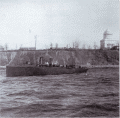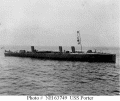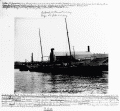
Photographic History of the United States Navy
ARCHIVE
| NavSource Main Page | FAQ | Contact us | Search NavSource |
 |
NavSource Naval History Photographic History of the United States Navy |
DESTROYER ARCHIVE |
| Click On Image For Full Size Image |
Size | Image Description | Contributed By And/Or Copyright |
|
|---|---|---|---|---|
 |
63k | Photo #: 80-G-K-17588. Captain David Porter, U.S.N. (1780-1843) portrait in oils, possibly by John Trumbull. Photographed September 1954 by PHC A.L. Brooks. This portrait is in the collections of the U.S. Naval Academy Museum, Annapolis, Maryland. Official U.S. Navy Photograph, now in the collections of the U.S. National Archives. David Porter was born at Boston, Massachusetts, on 1 February 1780. He entered the U.S. Navy as a midshipman in 1798 and served in the Quasi-War with France and the Barbary Wars. He became a prisoner-of-war when USS Philadelphia was captured off Tripoli in October 1803. Following his release in 1805, Porter commanded USS Enterprise and later was in charge of naval forces at New Orleans, Louisiana. During the War of 1812, Captain Porter was Commanding Officer of the frigate Essex during her wide-ranging assault on British shipping, a campaign that continued until Essex was overwhelmed by HMS Phoebe and Cherub at Valpariso, Chile, on 28 March 1814. Following the War, Porter was a member of the Board of Navy Commissioners and led an expedition to supress West Indies piracy in 1823-25. He resigned his commission in 1826 and spent three years as commander-in- chief of the Mexican navy. Porter died on 3 March 1843 while serving as U.S. Minister to Turkey. | Bill Gonyo | |
 |
78k | Admiral David Dixon Porter, USN, (1813-1891) was born at Chester, Pennsylvania, on 8 June 1813, the son of Commodore David Porter (1780-1843). His naval career began as a midshipman in 1829, and included service in the peacetime cruising Navy, the Mexican War and the U.S. Civil War. The latter conflict saw him rapidly rise from the rank of Lieutenant to Rear Admiral. In 1862, he was in charge of the Mortar Flotilla during the campaign to capture New Orleans and the lower Mississippi River. He took command of the Mississippi Squadron in October 1862 and led it through the active phase of the Western Rivers campaigns. Rear Admiral Porter spent the last several months of the Civil War in command of the North Atlantic Blockading Squadron. Following the War, Porter was promoted to Vice Admiral in 1866 and served as Superintendant of the Naval Academy. He became the Navy's senior officer, with the rank of Admiral in 1870, and remained an influential figure in naval affairs until his death on 13 February 1891. | NHC | |
 |
47k | Undated, color postcard. | Robert Hurst | |
 |
158k | Undated, an illustration of the Narragansett Bay excursion steamer Mount Hope and the torpedo boat USS Porter (Torpedo Boat # 6) underway at Newport, Rhode Island. Courtesy Rhode Island Historical Society. | Robert Hurst | |
 |
104k | Undated, USS Mckenzie (Torpedo Boat # 17) and USS Porter (Torpedo Boat # 6) in formation for a practice torpedo run. Image scanned from Building The Mosquito Fleet: The U.S. Navy's First Torpedo Boats, by Richard V. Simpson. | Robert Hurst | |
 |
86k | USS Porter (Torpedo Boat # 6) underway cruising at moderate speed. Location unknown. Image scanned from Building The Mosquito Fleet: The U.S. Navy's First Torpedo Boats, by Richard V. Simpson. | Robert Hurst | |
 |
313k | USS Porter (Torpedo Boat # 6) in dry dock at Brooklyn Navy Yard. Image scanned from Building The Mosquito Fleet: The U.S. Navy's First Torpedo Boats, by Richard V. Simpson. | Robert Hurst | |
 |
102k | USS Porter (Torpedo Boat # 6) underway, location unknown. Image scanned from Building The Mosquito Fleet: The U.S. Navy's First Torpedo Boats, by Richard V. Simpson. | Robert Hurst | |
 |
83k | Undated, USS Porter (Torpedo Boat # 6) underway, location unknown. Porter's armament consisted of four 6-pdr rapid-fire guns and three 18-inch Whitehead torpedo tubes. Image scanned from Building The Mosquito Fleet: The U.S. Navy's First Torpedo Boats, by Richard V. Simpson. | Robert Hurst | |
 |
119k | Undated, period postcard of Porter pours on the steam on her trial trip, location unknown. Image scanned from Building The Mosquito Fleet: The U.S. Navy's First Torpedo Boats, by Richard V. Simpson. | Robert Hurst | |
 |
255k | Undated, USS Porter (Torpedo Boat # 6) in dry dock at the Brooklyn Navy Yard. Note aft mounted 18-inch Whitehead torpedo tube. Courtesy Scientific American. Image scanned from Building The Mosquito Fleet: The U.S. Navy's First Torpedo Boats, by Richard V. Simpson. | Robert Hurst | |
 |
129k | Undated, USS Porter (Torpedo Boat # 6) underway, location unknown. Courtesy Scientific American. Image scanned from Building The Mosquito Fleet: The U.S. Navy's First Torpedo Boats, by Richard V. Simpson. | Robert Hurst | |
 |
180k | Undated, period stereo view card image of USS Porter (Torpedo Boat # 6) on the Hudson River, with Grant's tomb in the background. image scanned from Building The Mosquito Fleet: The U.S. Navy's First Torpedo Boats, by Richard V. Simpson. | Robert Hurst | |
 |
166k | Undated, USS Porter comes under the guns of the armoured cruiser USS New York. Original source unknown. Image and text from Building The Mosquito Fleet: The U.S. Navy's First Torpedo Boats, by Richard V. Simpson. | Robert Hurst | |
 |
234k | Undated, the heroic capture of an armed Spanish Schwartzkopf torpedo by Ens. Irving V. Gillis, from USS Porter. This was one of several torpedoes fired by the Spanish torpedo boat destroyer Pluton in the hope of catching any unlucky American ship they might encounter. Drawing by F. Cressan Schell. Image and text from Building The Mosquito Fleet: The U.S. Navy's First Torpedo Boats by Richard V. Simpson. | Robert Hurst | |
 |
171k | Undated, Ens. Irving V. Gillis attempting to unscrew the firing pin on the Spanish Schwartzkopf torpedo. From Harper's New Monthly Magazine, November 1898. The $3,000 value of the captured 1,000 pound torpedo was awarded to Ensign Gillies. The eventual destination of the weapon was the Naval Torpedo Station at Newport, where it was dismantled and its secrets evaluated. Today, that Schwartzkopf torpedo is occasionally exhibited at the Naval War College, at Newport's Naval Education and Training Center. Image and text from Building The Mosquito Fleet: The U.S. Navy's First Torpedo Boats by Richard V. Simpson. | Robert Hurst | |
 |
128k | Undated, U.S. Navy torpedo boats at dock in Newport Harbor at Goat Island. from left to right are USS Winslow, USS Stiletto, USS Morris and USS Porter. The Fall River - New York overnight steamer Pilgrim is in the far left background. NTS Photograph. Image and text from Building The Mosquito Fleet: The U.S. Navy's First Torpedo Boats, by Richard V. Simpson. | Robert Hurst | |
 |
52k | From left to right USS Cushing (Torpedo Boat # 1), USS Porter (Torpedo Boat # 6) and the USS Stiletto (Wooden Torpedo Boat 1), in Narragansett Bay, Rhode Island Sound, Rhode Island, 18 December 1896. Photographer Frank H. Child. Nathanael Herreshoff was on board the Porter when this photograph was taken, and recorded the date in his diary as having been on December 18, 1896. Source: John Palmieri, Curator Herreshoff Marine Museum/America's Cup Hall of Fame; www.herreshoff.org. Part of George Albert Converse papers and photographs, 1861-1897. Courtesy of DeGolyer Library, Southern Methodist University. | Robert Hurst | |
 |
61k | From left to right USS Cushing (Torpedo Boat # 1), USS Porter (Torpedo Boat # 6) and the USS Stiletto (Wooden Torpedo Boat 1), in Narragansett Bay, Rhode Island Sound, Rhode Island, 18 December 1896. Photographer Frank H. Child. Nathanael Herreshoff was on board the Porter when this photograph was taken, and recorded the date in his diary as having been on December 18, 1896. Source: John Palmieri, Curator Herreshoff Marine Museum/America's Cup Hall of Fame; www.herreshoff.org. Part of George Albert Converse papers and photographs, 1861-1897. Courtesy of DeGolyer Library, Southern Methodist University. | Robert Hurst | |
 |
86k | USS Porter (Torpedo Boat # 6) with an unidentified group of men underway in Narragansett Bay, Rhode Island Sound, Rhode Island, circa 1896. Photograph taken by Frank H. Childe. Source: John Palmieri, Curator Herreshoff Marine Museum/America's Cup Hall of Fame; www.herreshoff.org. Part Of: George Albert Converse papers and photographs, 1861-1897. Courtesy DeGolyer Library, Southern Methodist University. | Robert Hurst | |
 |
100k | USS Porter (Torpedo Boat # 6) underway during her trials in Narragansett Bay, Rhode Island Sound, Rhode Island. The man closest to the bow in the long top coat is Nathanael G. Herreshoff, designer and builder of the Porter. The date for the trials ran from 18 December 1896 to 10 February 1897. Photograph taken by Frank H. Childe. Source: John Palmieri, Curator Herreshoff Marine Museum/America's Cup Hall of Fame; www.herreshoff.org. Part Of: George Albert Converse papers and photographs, 1861-1897. Courtesy DeGolyer Library, Southern Methodist University. | Robert Hurst | |
 |
31k | A line drawing by A. D. Baker III of the torpedo boat USS Porter (Torpedo Boat # 6) as she appeared in 1896. Scanned from U.S. Destroyers: An Illustrated Design History by Norman Friedman. | ||
 |
144k | Circa 1897, location unknown. NHC photo 63750. | Terry Miller, Executive Director, Tin Can Sailors Inc./Thomas Becher | |
 |
129k | Newspaper clipping from the New York Tribune dated October 3 1897. | Mike Mohl | |
 |
119k | Appears to be same date and location as the above from a different angle. Digital ID: det 4a14664, Library of Congress Prints and Photographs Division Washington, D.C. | Bill Gonyo | |
 |
104k | Photo #: NH 63749. USS Porter (TB-6) photographed circa 1897-98. U.S. Naval Historical Center Photograph. | Terry Miller, Executive Director, Tin Can Sailors Inc. | |
 |
104k | Photo #: NH 101245-KN. USS Porter (TB-6) running trials in 1897. The original photograph was published on a color-tinted postcard by the Hugh C. Leighton Co., Portland, Maine, during the early 1900s. Courtesy of Commander Donald J. Robinson, USN(Ret), 1986. U.S. Naval Historical Center Photograph. | NHC | |
 |
196k | The photo used to make the above post card. Photo of the collection of the Vallejo Naval and Historical Museum. | Darryl Baker/Robert Hurst | |
 |
112k | Photo #: NH 64067. USS Porter (TB-6) running at high speed during her trials, circa 1896-97. Courtesy of the Smithsonian Institution. Image originally came from the Skerritt Collection, Bethlehem Steel Company Archives. U.S. Naval Historical Center Photograph. | NHC | |
 |
307k | A water-colour painting of USS Porter underway, circa 1898. Photo from "Our Country in War" by Murat Halstead. | Robert Hurst | |
 |
124k | USS Dupont (Torpedo Boat # 6) underway, with a hole in her bottom (suffered after bumping a coral reef), at full speed to join Commodore Schley's squadron at Santiago, Cuba, during the Spanish-American War. Image and text from Building The Mosquito Fleet: The U.S. Navy's First Torpedo Boats, by Richard V.Simpson. | Robert Hurst | |
 |
160k | Photograph of the USS Porter (TB-6), with diary entry. Lieutenant Commander Richard G. Davenport was aboard the Porter with Commodore Watson and staff for one afternoon when Spanish fleet left Santiago, 3 July 1898. Source: Naval History and Heritage Command, Photo No. NH 43804. | Mike Green | |
 |
172k | USS Porter engaging the batteries off San Juan. From Harper's New Monthly Magazine, November 1898. Image and text from Building The Mosquito Fleet: The U.S. Navy's First Torpedo Boats, by Richard V. Simpson. | Robert Hurst | |
 |
96k | USS Porter chasing a suspicious sail, circa 1899, location unknown. Photo from "The great battles of all nations" by Archibald Wilberforce. | Robert Hurst/Mike Mohl | |
 |
85k | Starboard bow picture of USS Porter (Torpedo Boat # 6) alongside an unidentified armed yacht, on 11 June 1899, location unknown. Photo # 19-N-13868 from Haze Gray & Underway. | Robert Hurst | |
 |
174k | Foote (TB # 3), Ericsson (TB # 2), Morris (TB # 14) Cushing (TB # 1) and Porter (TB # 6) (or Dupont TB # 7) at Norfolk Navy Yard, circa early 1900s. Period postcard. Image and text from Building The Mosquito Fleet: The U.S. Navy's First Torpedo Boats, by Richard V. Simpson. | Robert Hurst | |
 |
138k | Photo #: 19-N-14-24-12. Torpedo Boats at the New York Navy Yard, Brooklyn, New York In November 1900. They are, from left to right: USS Winslow (Torpedo Boat # 5); USS Ericsson (Torpedo Boat # 2); USS Cushing (Torpedo Boat # 1); USS MacKenzie (Torpedo Boat # 17); and USS Porter (Torpedo Boat # 6). Photograph from the Bureau of Ships Collection in the U.S. National Archives. | NHC | |
 |
234k | Post card from 1901 along with the monitor USS Puritan. | Tommy Trampp | |
 |
251k | Photo #: NH 100917. Two U.S. Navy Torpedo Boats at the Norfolk Navy Yard, Virginia, circa late 1905. These are probably USS Porter (Torpedo Boat # 6) and USS DeLong (Torpedo Boat # 28). The decommissioned cruiser San Francisco is at left and the collier Ajax is in the center background, with other torpedo boats alongside her. Courtesy of Ted Stone, 1986. U.S. Naval Historical Center Photograph. | NHC/Robert Hurst | |
 |
189k | USS Rodgers (TB-4), USS Porter (TB-6), USS DuPont (TB-7), USS Blakely (TB-27), USS Nicholson (TB-29) and USS O'Brien (TB-30) in Norfolk circa 1905. | Bill Gonyo | |
 |
194k | Civilian Norfolk Navy Yard workers are busy making repairs on the torpedo boat USS Porter (TB-6) circa 1905. Photo courtesy of the Library of Congress. | Bill Gonyo | |
 |
199k | The torpedo boats USS Porter TB-6 (left) and USS Du Pont TB-7 (right) are visiting the city of New Orleans, Louisiana in 1906. Photo courtesy of the Library of Congress Prints and Photographs Division. | Bill Gonyo | |
 |
65k | Photo #: NH 100042. Norfolk Navy Yard, Portsmouth, Virginia. Torpedo boats of the Atlantic Fleet Reserve Torpedo Flotilla at the Norfolk Navy Yard, circa 1907. Most of these craft are partially dismantled. The two boats in the front right and the one in the front left (listed in no particular order) are: USS Bagley (TB-24), USS Barney (TB-25) and USS Biddle (TB-26). The two larger boats between them, in the foreground are (left to right): USS DuPont (TB-7) and USS Porter (TB- 6). The three boats in the back row are (left to right): One of the three Torpedo Boat # 3 class (Foote, Rodgers or Winslow), USS Cushing (TB-1) and either USS Gwin (TB-16) or USS Talbot (TB-15). The receiving ship USS Franklin (1867-1915) and a two-masted schooner are in the distance. Courtesy of R.D. Jeska, 1984. U.S. Naval Historical Center Photograph. | NHC | |
 |
81k | Photo #: NH 100418. Hudson-Fulton Day celebrations, October 1909. Five U.S. Navy torpedo boats at Troy, New York, for Hudson-Fulton Day, 9 October 1909. The two torpedo boats at left are (in no order): USS Porter (Torpedo Boat # 6); and USS DuPont (Torpedo Boat # 7). The other three are (from left center to right): USS Blakely (Torpedo Boat # 27); USS Shubrick (Torpedo Boat # 31); and USS Stockton (Torpedo Boat # 32). Courtesy of Jack Howland, 1985. U.S. Naval Historical Center Photograph. | NHC | |
 |
186k | USS Dupont (Torpedo Boat # 6) in Navy Parade, North River, New York, 1909. Image and text from Building The Mosquito Fleet: The U.S. Navy's First Torpedo Boats, by Richard V.Simpson. | NHC | |
LT John Charles Fremont Feb 20 1897 - ? (later RADM) LT Harold Raynsford Stark May 14 1909 - ? (Later ADM)
| Back To The Main Photo Index | To The Destroyer Index Page |
